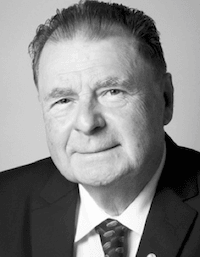Richard F. Heck
1931 – 2015
Richard F. Heck, a giant in the field of organic chemistry, died on October 9, 2015. Beginning in the late 1950’s, Heck envisioned that as the art of organic synthesis grew there would be a need for catalytic, organometallic-mediated bond-forming reactions that were tolerant of a wide range of functional groups. Research investigations led him to the Pd(0)/Pd(II) cycle of oxidative addition and reductive elimination, by which carbon-X bonds are catalytically converted to carbon-carbon and carbon-heteroatom bonds. His investigations laid the groundwork for all catalytic, organometallic, bond-forming processes that are used currently in modern organic synthesis.
The epic importance of catalytic palladium-mediated, carbon-carbon bond formation only slowly became apparent to the organic synthesis community. When his Organic Reactions chapter appeared in 1982, coverage of all the literature required only 45 pages (including tables!). By 2002, applications of his chemistry in synthesis had grown to the extent that the Organic Reactions chapter published that year, limited to the subset of intramolecular Heck Reactions, covered 377 pages. Moreover, the original 45 page chapter, despite its size, it is the most highly cited chapter in the Organic Reactions series with over 1500 citations!
Professor Heck received number of awards for his seminal contributions to chemistry, most notably sharing the Chemistry Nobel Prize in 2010. Among his many professional activities, he served as a member of the Editorial Board of Organic Reactions, Inc. from 1973 – 1985.
On a personal note, Dick Heck had already been publishing on palladium-catalyzed carbon-carbon bond formation for ten years, at the time that I joined the chemistry faculty of the University of Delaware in 1982. It was apparent that the intramolecular Heck reaction could be a powerful transformation. I sketched out some possible applications to Dick and offered to help his students, but he was not interested. He preferred to continue exploring new reactivity, initiating both “Suzuki coupling” and the “Sonogashira reaction”. Although he was the first to fully characterize a π-allylmetal complex and to elucidate the mechanism of cobalt-catalyzed alkene hydroformylation, he most enjoyed discussing the addition of formate to the palladium-catalyzed carbonylation reaction, leading to the formation of aldehydes. Even in retirement, Dick was eager to keep up with the literature, so I would send a selection of the most interesting articles every few months. He found the Catellani protocol particularly intriguing. He had thought that the carbon-palladium bond would be far too labile to allow such cascade transformations.
Dick is remembered for the key role he played as a pioneer in applying transition metal catalysis to the synthesis of complex organic molecules, both in academics and in industry. Before Grubbs, Schrock, Buchwald or Hartwig – indeed, before Stille, Suzuki, Negishi, Tsuji, Trost or Sonogashira – there was Heck pointing the way. From the late 1950’s on, his contributions provided the creative spark that ignited this essential subdiscipline of synthetic methodology. In the words of Professor E. J. Corey: “Of all the individuals who have contributed to the spectacular progress in palladium catalyzed synthesis, there is no one whose work is as seminal or significant than that of Richard F. Heck.”
Douglass F. Taber, University of Delaware
November 10, 2015


